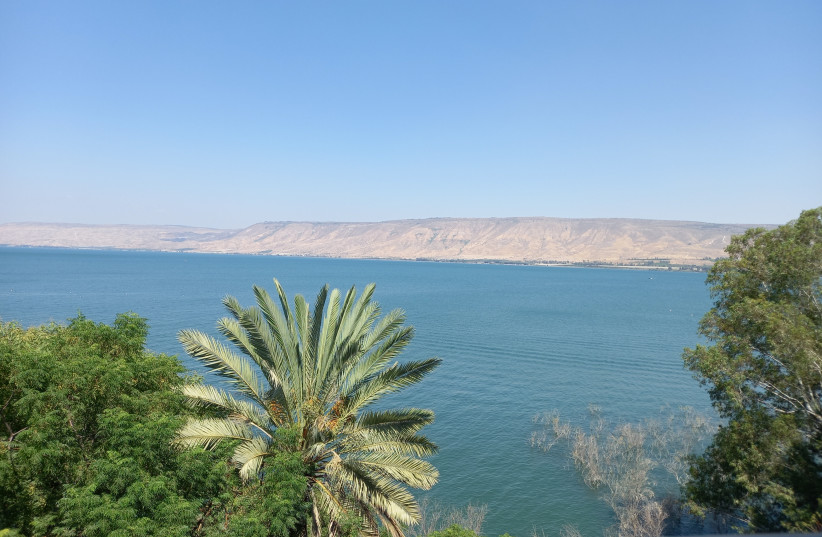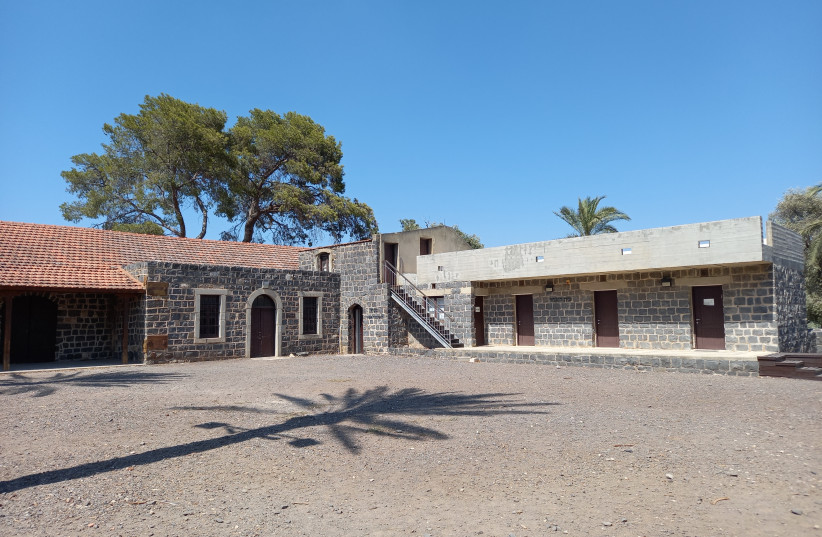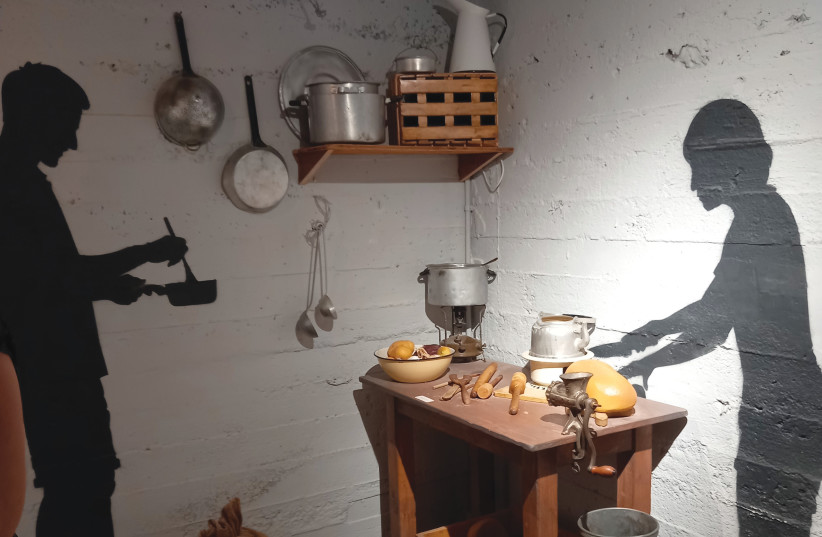I had a taste of the past during a recent trip to the area around the Kinneret (Sea of Galilee). It tasted sweet, the taste of fresh dates.
The Council for Conservation of Heritage Sites in Israel hosted a press tour to show some of the attractions in the region, especially within the framework of the Israeli Shabbat project in combination with the Culture and Sport Ministry, which offers free entrance and tours at many sites. We traveled North on a Thursday for a day trip with an ambitious itinerary that gave us a glimpse at several sites, each worthy of longer visits.
Our visit started at Shmueli Courtyard at Sejerah (Moshava Ilaniya) where, in a stone building with family portraits on the wall, Esther Shmueli-Stepman, dressed up peasant-style to tell her family’s story: “One ordinary day, while he was going about his everyday work, at the sound of the church bells in his village, Kurakin received the Divine message to leave his home and his religion and set out on a new path; 163 people, 37 families, left their icons and crosses with the priest and left the village of Solodniki and followed Kurakin to the Land of Israel, among them, my great-grandfather, Eliyahu Protopopov.”
The story is a fascinating tale of the Subbotniks (the Sabbath observers), who traveled from Russia to work in the agricultural communities of the Galilee more than a century ago. Kurakin’s whole community converted to Judaism (a journey in itself) in Russia. While we were offered a wine tasting from the family winery run by Shmueli-Stepman’s brother, sitting in the shade near a stone well, we saw a member of the sixth generation of the family that, 121 years after its arrival, still calls the houses around the courtyard home.
<br>A sweet date at the Kinneret
From the Shmueli Courtyard, we traveled to a better known site, Kibbutz Kinneret. Here we started at the Tnuvat Kinneret Visitors Center and Store. The attractive 600-sq.m. store sells, among other things, the 10 species of dates grown in the area, silan (vegan honey from dates), honey from different trees (including, for example, avocado and lychee), wines, Galilean spices and gift packages. I discovered a taste for the Halawi dates, eaten frozen, and the “super juicy Medjools.”

We learned of the labor-intensive process behind date production. Palm trees are either male or female and the pollen from the males has to be manually introduced to the females to produce dates. Here, too, the pioneering agricultural history is evident. Although dates are one of the Seven Species mentioned in the Bible, the palm trees that now give the characteristic look to the area from the Kinneret down through Beit She’an and the Jordan Valley, and the Arava, were reintroduced (at great risk) from places like Iraq, Egypt and Iran in the 1930s. Ben-Zion Israeli from Kibbutz Kinneret was behind most of those clandestine operations.
We passed rows of upright palm trees laden with ripe red dates on our way to have lunch at Kibbutz Kinneret’s Ohalo Manor Hotel. The (kosher) meal was fantastic, complemented by local wines and an amazing view of the Kinneret. After years of drought, the Kinneret is full this year and more beautiful than ever. No wonder so many songs were written about it, some of the most enduring by the Kibbutz Kinneret members of old, Rachel Bluwstein, known as Rachel the Poetess, and songwriter Naomi Shemer. Feeling sated and satisfied after the meal, we went up to the terrace to get an even better panoramic look at the Kinneret. I couldn’t help but think of Rachel’s words set to music by Naomi Shemer:
“Over there are the hills of Golan,
Stretch out your hands and touch them.
In their stalwart stillness, they give the
command to halt.
In splendid isolation
Grandfather Hermon slumbers.
And a cool wind blows from the peak of
whiteness.
Over there, on the seashore,
a low-topped palm tree stands,
disheveled like a mischievous infant that
has slid down and splashes in the waters of
the Kinneret....”
<br>In the footsteps of pioneers
Instead of sliding down to splash in the waters like mischievous infants (which was very tempting), we continued our journey back in time, to a period when the waters were lovely and inviting but the surrounding land and life were harsh.
Our next stop was the Kinneret Courtyard, founded in 1908 as an agricultural training center. Her time here was probably the happiest period of Rachel’s life. She was among the first students of agronomist Hana Meisel-Shohat. Meisel-Shohat, we learned, fought the original intentions to keep the women just in traditional tasks like cooking and established the agricultural vocational training school for young women. Among the other important figures in Zionist pioneering history who passed through Kinneret Courtyard were A.D. Gordon, Berl Katznelson, and Zalman Shazar. The farm closed in 1917 during the First World War.
The final stop on our too-brief trip was Gesher and Naharayim. The pioneers arrived here on the banks of the Jordan River in 1920. In 1927, in an extraordinary forward-thinking idea for the time, work began on building a hydroelectric power plant at the meeting point of the Jordan and Yarmouk. (Naharayim means two rivers in Hebrew.)

Pinhas Rutenberg’s vision was to establish 12 such plants along the Jordan. That plan failed to materialize but the Naharayim plant provided electricity to communities in pre-state Israel and Transjordan until it was blown up in the War of Independence in 1948. A sound-and-light show constructed around the remains of the original plant, with running water and other special effects, tells the story of Rutenberg, and the power plant that symbolized peace (and war).
<br>A bridge to the past
War and peace were also the dominant themes evident at Gesher, whose story is reminiscent of the tale of Kibbutz Nitzanim made famous in Avi Nesher’s powerful new movie Image of Victory.
After two failed attempts at settling the area, in 1939 another group of men and women arrived to build their homes along the Jordan River and create a typical kibbutz society based on principles of equality and hard work.
In a short movie of the history of the kibbutz, members recall how they became the front line, repelling forces trying to invade Israel in 1948. In April, before independence had been declared, kibbutz members in the field noticed the British abandoning the nearby Tegart fort, which had served as a police station, guarding the three bridges that crossed the river. Kibbutzniks desperately raced to take over the fort, which Jordan’s King Abdullah planned to use to secure a bridgehead.
The kibbutz did not have a chance to evacuate the children and the video tells the stories of infants who were rushed to the main bunker and underground control room where the wounded were also treated.

Some 120 members of the isolated kibbutz faced more than 3,000 well-armed Arab forces. The Jordanian Arab Legion and Iraqi army sent armored, artillery and infantry troops to the strategic spot.
After a lull in which the children and wounded were evacuated, the remaining few members bravely held out. Defense efforts included blowing up the bridges, one built by the Romans; one for trains built by the Ottomans, and one by the British.
Kibbutz Gesher was destroyed in the fierce fighting, and survivors rebuilt it after the war, slightly to the west on higher terrain. “Old Gesher” is now a heritage site and we watched the movie in the former kibbutz dining room before touring the command bunker-turned-inspiring museum. There are many other sites and attractions to see in the area, but we ran out of time before we ran out of interest.
Before we left, we looked in at the small, quaint Agadat Lechem (Tale of Bread) restaurant/bar (kosher). Although it wasn’t operating during our trip, we got a good idea of the ambience of the place, which houses the original brick oven that was used by the kibbutz members.
Whether you’re traveling for an Israeli Shabbat event or on a weekday, particularly this time of year, it’s worth keeping in mind that most of the guided tours and activities are indoors – many in cool, basalt stone buildings with air conditioning the early pioneers could not have imagined.
We got just a taste of what there is to see, do and eat. I returned home with an appetite for more.
The writer was the guest of the Council for Conservation of Heritage Sites in Israel. For more details.
